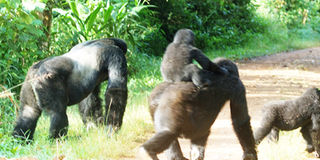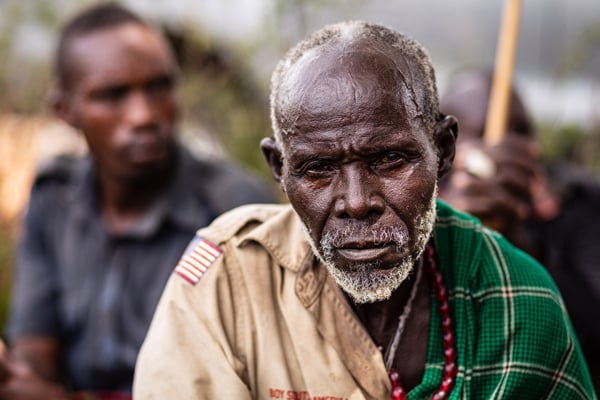Prime
A day fulfilled with playful Bwindi gorillas

It was a hit and miss affair whether I would actually see the gorillas but thanks to two cheerful and confident trackers, I was able to have a memorable Easter Monday with man’s closest relatives, writes Jossy Muhangi
It is Easter Monday morning. I have taken a sojourn to Bwindi Impenetrable National Park in Southwestern Uganda, a leading destination for local and international tourists thirsty for interacting with the rare mountain gorillas. Iprepare myself mentally and physically for piercing through the tangled vegetation and the slippery meandering trails along the steep-sided-rugged ridges of the forest, in search of at least one family of the rare gentle beasts.
John and Charles, the cheerful and confident trackers who monitor the movements of the gorilla groups, assure me that they spotted some gorillas constructing nests the previous evening and that they must have spent the night in the vicinity of the national park office block at Buhoma. “But, gorillas being what they are, they might wake up at sunrise and trek deeper into the forest in search of their favourite food beyond the ridges and valleys,” remarked Charles, pointing at adjacent ridges.
But as soon as we hit the jungle behind the park office premises, the two trackers wielding mini machetes they use to create the trails through the thicket, one of them spots the footmarks of an adult gorilla and quickly observes that it must have wandered off from the rest of the group, if not a solitary individual.
As we retreat a bit to consider another direction, there is a sudden grunt from what the tracker says is the dominant male gorilla - the silverback, signalling that the gentle beasts are within our reach. John, the tracker, grins with excitement and confidence that the sound has come from Mwirima, the dark-faced leader of the Rushegura group which comprises 19 members, among them five adult females, several juveniles, infants and sub adults. The group is called Rushegura because it separated from a bigger one called Habinyanja on Valentine’s Day of 2002, at a place called Rushegura.
The tracker responds to the grunting vocalisation with some non-verbal communication, which he tells me is an assurance to the gorillas that it is their usual human friends and not enemies approaching. He also says the grunting from the silverback is a polite warning to whoever is approaching their territory, having heard the footsteps and human voices.
Without a moment’s delay, we head in the right direction for a misty spot under the canopy of towering trees occupied by the gorillas, which are enjoying their breakfast with such gusto. On seeing two infants engaged in what appears like a wrestling game under the close watch of two adult males assuming the role of umpires, I almost forget the caution of observing at least 15 feet away from the feeding group until a Uganda Wildlife Authority (UWA) tracker warns that a silverback is keenly watching and taking charge of “everyone’s” security.
On close identification of their nose prints and body sizes, the trackers tell me the infants are the babies of Karungi and Kirinvi, while the babysitters/umpires are Kalembeezi and Kanywani. Kanywani, (Rukiga for friendly), is known for being playful and giving company to infant gorillas, but is equally watchful and protects them against danger.
On the other hand, Kalembeezi, (Rukiga for caring), ensures the welfare and comfort of the infants is not compromised. In fact, Kalembeezi mesmerises the visitors by the magical way he carries the infants by strapping them sideways onto his laps. Infants usually ride on their mothers’ backs or perch on their abdomen as the female adults walk on their stocky legs and the knuckles of their massive long fore limbs.
According to the trackers and guides here, Kalembeezi is the third in command after Kabukojo, another healthy sub adult male that is soon graduating into a blackback. The two assist the silverback, Mwirima, by providing side security and acting as sentries. Indeed, on this Easter Monday, the two ensure all the members have left one area to another during their feeding spree by trailing their colleagues, led by the silverback.
Spoon feeding or respect?
Another captivating sight is of the mother gorillas climbing majestically and confidently with their babies riding on their backs to feast on fruits and parasitic plants. Occasionally, some of the infants fall down from high up the trees but it is hard to establish if they get injured. However, a tracker tells me some die in such accidents when they hit their heads against hard objects like rocks.
On this day, the silverback is curious but also generous. In spite of his massive weight, he climbs a nearby tree with ease and picks and munches on ripe fruits while throwing others down for the infants and juveniles. The guides, who passionately watch this behaviour, say the subordinate members of the group, out of respect, cannot dare follow their boss up the tree and will follow suit after he has had his fill.
However, the adult female, Karungi, a pretty mother of infant and juvenile daughters and said to be Mwirima’s favourite mate, comfortably follows the silverback up the tree, her baby on her back.
Since gorillas’ human friends respect their feeding, resting and movement itinerary, I can’t spend a longer time with the gentle creatures than I had wished. From the trackers, I learn that later in the day, the gorillas have a health break during which the infants and juveniles play while others rest and some groom one another by picking foreign articles from their thick fur.
I crown my Easter Monday by taking a more than 5.6km meandering trek to the Munyaga Waterfalls, right, serenaded by the continuous throbbing rhythm of the river and singing birds, particularly the African Emerald Cuckoo, whose role is to welcome visitors to the forest.




